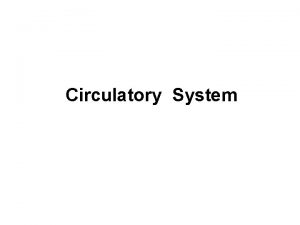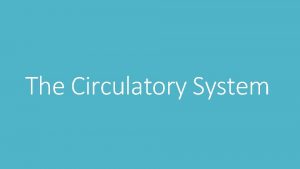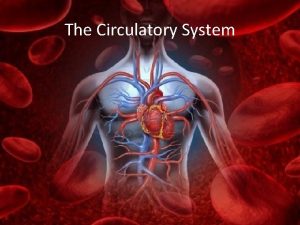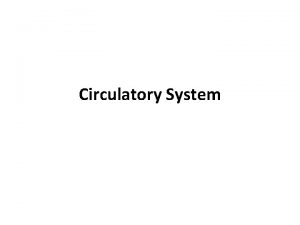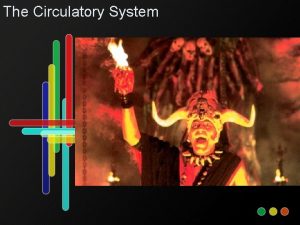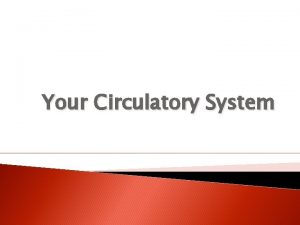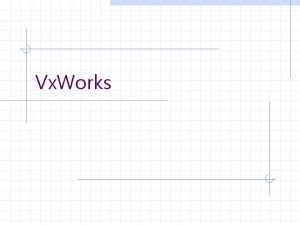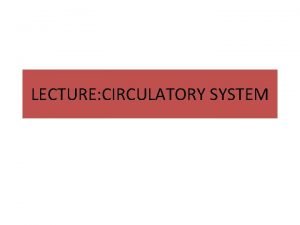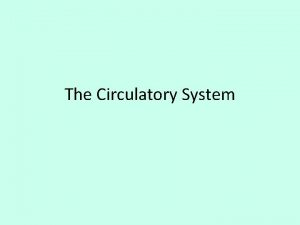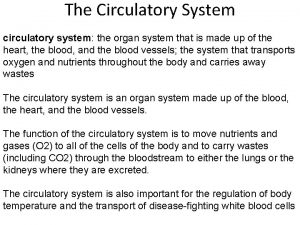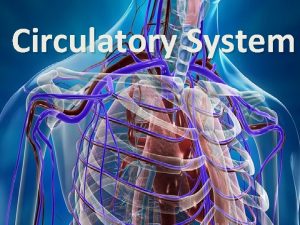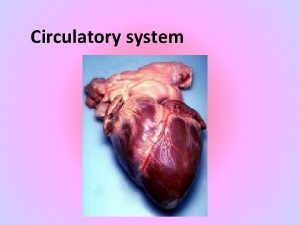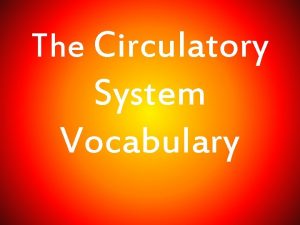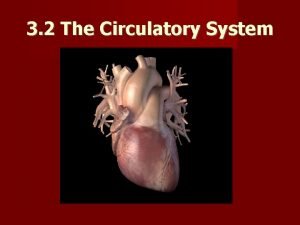Circulatory System Circulatory System The circulatory system works


















- Slides: 18

Circulatory System

Circulatory System The circulatory system works closely with the respiratory system. As the heart rate changes, so does the breathing rate. The circulatory system transports materials through the body. The blood carries oxygen, food, and water to the cells and removes carbon dioxide and waste from them.

Circulatory System The circulatory system is made up of vessels and muscles that control the flow of blood through the body. Parts of the circulatory system include: Heart veins venules arterioles capillaries

Circulatory System Types of Vessels: Arteries: These are the largest of the blood vessels…. . they carry blood AWAY from the heart. They appear as thick pink lines. Veins: These carry blood TO the heart. These are the medium sized vessels. They appear as thick blue lines. Capillaries: The smallest of the blood vessels. They appear as tiny thin lines and are only 1 cell thick. They connect the arteries to the veins. The thin layer allows molecules of oxygen, water, and lipids ( fats ) to pass through and enter the tissues. Waste products such as Carbon Dioxide and urea can pass back into the blood to be carried Away for removal from the body.

Circulatory System Veins carry blood back to heart Arteries carry blood AWAY from heart *** A good way to help you remember… A. . A Arteries Away

Circulatory System The heart is made up of cardiac ( heart ) muscle which is part of the involuntary muscle system of the body. This system is one we cannot consciously control, but is controlled by parts of our brain automatically. The heart contracting is what causes the blood to flow from the heart to the rest of the body.

Circulatory System Blood pressure is the force at which your blood is sent throughout the body.

Circulatory System As blood begins to circulate, it leaves the heart from the left ventricle and goes into the aorta. The aorta is the largest artery in the body. The blood leaving the aorta is full of oxygen. The oxygen rich blood travels throughout the body in arteries which break into smallest arterioles.

Circulatory System There are four cavities or open spaces inside the heart that fill with blood. We call these chambers. The two chambers at the top are called “atria”. So, there is a left atrium and a right atrium The two chambers at the bottom are called “ventricles”…so there is a left ventricle and a right ventricle. So, basically, the heart is said to have 4 chambers.

Circulatory System On its way back to the heart, the blood travels through a system of veins and venules. As it reaches the lungs, the carbon dioxide ( a waste product ) is removed from the blood and is replaced with fresh oxygen that has been inhaled through the lungs.

Circulatory System Blood Cells: Red blood cells: Contain hemoglobin which combines with oxygen. These cells deliver oxygen to the body. Their disc shape helps them to squeeze through the tiny capillaries. They wear out and are replaced every 4 months. New red blood cells are produced in the bone marrow. They make up 40% of the blood’s volume.

Circulatory System Blood Cells cont. : White blood cells: Are generally larger than red blood cells. They can move out of your blood through the capillary walls into tissue fluid and lymph. They then travel around fighting disease. The white blood cells last 13 -20 days, after which they are destroyed by the lymphatic system. You have about 1 white blood cell to every 600 -700 red blood cells.

Circulatory System Blood Cells cont. : Hemoglobin: A protein found in Red Blood cells that carries the oxygen. Without hemoglobin, the oxygen would not be carried in the blood and would have no way to get to the cells.

Circulatory System Blood Cells cont. : Platelets: Found in the red blood cells. Are irregular in shape and are colorless bodies that wear out within 5 -10 days. Their sticky surface lets them, along with Calcium, Vit. K, and fibrinogen, form clots to stop bleeding. They are smaller than the RBC’s or WBC’s.

Circulatory System Blood Cells cont. : Plasma is the liquid component of blood, in which the red blood cells, white blood cells, and platelets are suspended. It constitutes more than half of the blood's volume and consists mostly of water that contains dissolved salts (electrolytes) and proteins.

Circulatory System

Circulatory System Interesting Facts about your Circulatory System: üA young person has about a gallon of blood. An adult has üabout 5 quarts ( which is about 5 liters ) üThe heart is a Muscle about the size of your fist…. go ahead ütake a look at your fist. üYour heart will beat about 3 billion times during a normal ülifespan. üYour heart is located in the center of your chest, slightly to üthe left.

Circulatory System üAbout 8 million blood cells die, in the human body every second, üand the same number are born each second. üWithin 1 tiny droplet of blood, there about 5 million red üblood cells. üIt takes about 20 seconds for your blood to make one trip üthroughout your entire body. üDid you know that even when your heart is taken out of your übody it will continue to beat?
 Safety at streetworks
Safety at streetworks Circularory system
Circularory system How respiratory system work with circulatory system
How respiratory system work with circulatory system Circulatory system and respiratory system work together
Circulatory system and respiratory system work together Hát kết hợp bộ gõ cơ thể
Hát kết hợp bộ gõ cơ thể Lp html
Lp html Bổ thể
Bổ thể Tỉ lệ cơ thể trẻ em
Tỉ lệ cơ thể trẻ em Gấu đi như thế nào
Gấu đi như thế nào Chụp tư thế worms-breton
Chụp tư thế worms-breton Hát lên người ơi
Hát lên người ơi Các môn thể thao bắt đầu bằng từ đua
Các môn thể thao bắt đầu bằng từ đua Thế nào là hệ số cao nhất
Thế nào là hệ số cao nhất Các châu lục và đại dương trên thế giới
Các châu lục và đại dương trên thế giới Cong thức tính động năng
Cong thức tính động năng Trời xanh đây là của chúng ta thể thơ
Trời xanh đây là của chúng ta thể thơ Mật thư tọa độ 5x5
Mật thư tọa độ 5x5 101012 bằng
101012 bằng độ dài liên kết
độ dài liên kết



















